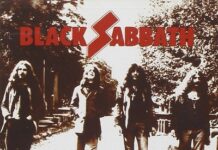As a born and bred New Jerseyan living and breathing rock music in the 70s, I have heralded every Bruce Springsteen album as monumental occurrence in my life. After Springsteen’s success with 1975’s classic Born To Run, everybody I knew were waiting with bated breath for the follow up, which turned out to be 1978’s Darkness On The Edge Of Town.
A big reason for the three-year wait is that Springsteen had to endure a much publicized legal fight with his manager, where he was kept from recording for a time. This fourth album certainly reflects a darkness in its lyrics, with Springsteen’s characters now grown up and in many situations, living dead–end lives. Springsteen has often said he feels Darkness On The Edge Of Town was a little too wordy, that he would have preferred more musical passages. In listening back, it would seem almost every song here works as a rock and roll nugget of perfect production. Perhaps, the Boss simply had lots to say at this point in his life.
From blistering opening of “Badlands,” this album reveals “Professor” Roy Bittan’s amazing piano playing, all the way to the somber album-ending title track with its exploding choruses. In many ways, I feel this might be Springsteen and his E Street Band’s true crowning glory, as The River is too long, Nebraska a stripped down, at times indulgent solo turn, and Born In The USA not very strong at all, even in with its worldwide success. Darkness On The Edge Of Town is also notable in that guitarist Steven Van Zandt is given a co-production credit, and if there was ever anyone who knows horn interplay (he was brought into the Born To Run sessions to help with the horn arrangements), harmony vocals, subtle guitar production and can push Springsteen to his full potential, it is Steven Van Zandt.
“Badlands” does snap, but the distorted single-note riffing and pull offs of “Adam Raised A Cain” make it an even better tune. On the 2010 remaster, we get to hear Garry Tallent’s bass and Danny Federici’s organ clearly under Springsteen’s screams. The band really is firing on all pistons and this take on a classic phrase and story is turned on its head by the Boss’s eloquent lyric. “Something In The Night” is classic Springsteen, the lyric evoking lonely and windswept Jersey streets, his plaintive wail aligned, and drummer Max Weinberg providing his big snare hits to what is pretty much a stark production. This is one of the album’s great songs, the one we had all been hoping for, a true successor to “Backstreets” from Born To Run.
On the sexual paean “Candy’s Room,” we hear Weinberg’s distinctive high hat opening, the singer taking a breath before he exhales the vocal and the tinkling touch Bittan’s piano following along. “Racing In The Streets” is the centerpiece of the album, a story of racing friends at the end of their desperation is painted painstakingly by a simple lyric, akin to Born to Run’s “Jungleland” with more maturity to the story. I have heard this song hundreds of time and it never fails to evoke chills up and down my spine. The subtle backing “ohhs” near the end, Bittan and Springsteen locked together, and Federici’s single-note organ solo leaves the listener breathless.
Not all of Darkness On The Edge Of Town works though. “Factory,” despite its catchy chorus and full use of Federici, still plays too stiff for me. Plus, the lyric is too obvious and well below Bruce’s skill. “Streets Of Fire” is another song that doesn’t do much, I’m afraid. Like “Factory.” the lyrics are trite, Springsteen avoids getting too specific (and his strength as a lyricist is his specificity), and the band is competent, but nothing that’s outstanding. Redemption is at hand however. “Prove It All Night” has the Boss name- dropping towns and pushing forward over Tallent’s best bass parts of this album, with a classic harmony vocal and big choruses. Springsteen makes some broad statements, sometimes a little banal, but mostly on course to keep the song personal…and rocking. Interestingly enough, Darkness On the Edge Of Town features judicious (some argue too little) use of “Big Man” Clarence Clemons, although when the sax does appear, it is passionately placed and well played, as it is on “Prove It All Night.”
With the title track, we are in and out of Bruce Springsteen’s world view at the time and want back in, as I did playing this album, especially the first side, over and over again when I first bought it. What is now an iconic solo shot of Bruce Springsteen on the front cover truly captures his state of mind and what one finds on Darkness On The Edge Of Town — a great album by a great American musical artist.
~ Ralph Greco, Jr.




















